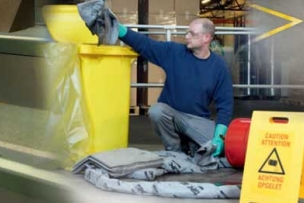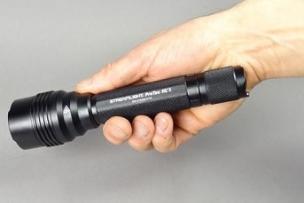Serve Packaged Foods in the Cafeteria
If your facility has a cafeteria or breakroom that serves food, provide prepackaged foods and eliminate any live food stations or open multiserve containers.
“Plus, only a certain number of people go into the space at a particular time to purchase their food and then they move through to allow for that 6 feet of space in between people,” she says.
Stagger Work Shifts and Breaks
Any manufacturing or distribution facility really must think about using or how they use shifts and hours, Roy advises, adding that many companies have shared that they are also separating their shifts.
“There’s time in between when one shift comes in and the other goes out so [workers] all don’t comingle at the same time,” she says. That also allows for cleaning in between shifts and for practicing social distancing as the workers come and go from the workplace.
To learn more from the ASSP webinar and also find additional resources shared by the society, visit the ASSP Coronavirus resources page.
Managing Safety Best Practices During a Viral Outbreak
For any safety manager, risk is always a top concern: What is the level of hazard versus exposure that the business must worry about? “The thing to keep in mind with the novel coronavirus is that it spreads very easily,” Roy notes. Plus, World Health Organization research now shows asymptomatic transmission of COVID-19 is possible.
Businesses need to take into account as well, Roy says, that there currently is no cure or vaccine. Even though many people only suffer mild symptoms, for others, it’s deadly, and that must be a concern in the workplace, she says. “The key with this particular virus is that it may be a high-level risk for some individuals.”
While the highest number of deaths have been associated with older individuals and those with underlying conditions, there are some younger individuals who have gotten critically ill and died. “We don’t know why,” and that makes the need of proactive safety actions important because “we don’t know who would have a low level of symptoms versus a high level,” Roy says.
She recommends new COVID-19 guidance from the Occupational Safety and Health Administration. It addresses the risk of exposure and talks specifically to the levels of risk.
“They do a nice job outlining that,” Roy says. “I really like the OSHA document. They give good suggestions on social distancing too.”
PPE Considerations for Virus Protection
During her presentation, Roy also addressed the need for personal protective equipment, and in particular N95 respirators.
Her recommendation is that businesses should apply the Hierarchy of Controls. “We really want to start at the top and not start at the bottom” with PPE, she says. Instead, safety teams should look at how to avoid the risks and hazards rather than use PPE to mitigate them.
Review this safety prioritization methodology from the National Institute for Occupational Safety and Health in our Hierarchy of Controls primer.
“The focus often in a situation that’s uncertain is to just go to PPE,” she says. “The fact is that we have to back up and go to ‘How does the virus transmit?’ ”
Typically, in a traditional warehouse or manufacturing situation, Roy explains, the scientific thinking is that the droplets spread by a cough will travel no more than 6 feet. “In that particular context, if you think about N95 masks, if you have people moving around a warehouse, or sitting in a call center, and they have space around them, the potential for exposure is relatively low.”
This is not to say that certain PPE would not or should not be deployed. But Roy suggests that safety teams evaluate the risks in their particular workplaces “based on the severity of the risks. Then, based on that, you use the appropriate PPE accordingly.”
In a warehouse or manufacturing situation, “most people are using gloves,” Roy notes. Using masks is not necessarily needed in circumstances in these facilities if hygiene and social distancing are being well implemented, she says.
It’s absolutely critical that people use proper hand-washing hygiene and also to clean all high-touch surfaces often. She recommends that businesses use the National Institutes of Health’s initial research on how long COVID-19 droplets can survive on surfaces. NIH found that on plastic and stainless-steel surfaces, the virus can live for as long as three days, and on cardboard for up to 24 hours.
As information changes, she added, the recommendations from health officials could change. And, because safety teams must manage a risk that is a virus, CDC guidance would take precedence over OSHA’s PPE standard.
COVID-19 and OSHA Compliance
What are the compliance issues that businesses need to manage during a viral outbreak? In the OSHA coronavirus guidance, the agency raises the general duty clause, Roy notes, adding that “the expectation is that you do more and that you protect people from this” virus.
She recommends using the bloodborne pathogens standard as a good framework to apply, though it does not technically require anything of a business with regard to the coronavirus because the standard does not address sputum. Roy finds it helpful as a planning tool because it has approaches that businesses can apply to the current needs related to COVID-19.
On recordkeeping, OSHA has changed the guidance.
“When you have an outbreak at a workplace, you do have to look at that differently than the usual cold and flu,” which are exempted from the OSHA reporting rules, Roy says.
OSHA clarified that “you first have to do the same thing you always do with recordability for OSHA. You want to determine if it’s a confirmed case.”
Roy lays out the three steps that are required:
- First: “Confirm that the case is COVID-19.” Your employee should be able to provide that documentation from their healthcare provider.
- Second: Next, you must determine if the case is work-related. “This is where I think a lot of people get concerned because they’re not sure whether or not it’s work-related,” she says. “If you have another known case in your workplace and that person was a close contact in that workplace [typically, 15 minutes or more of contact within 6 feet], then you would need to consider it to be a work-related case.” She adds, “You have to really do an assessment of that case, just like you would any other case as whether it should go into the OSHA log for being work-related.”
- Third: “You have to consider whether the case involves one or more general recording criteria.” The most obvious is medical treatment, which immediately makes it a recordable incident. The other that’s likely to be involved during a viral outbreak like coronavirus is days away from work.
Learn more about federal safety reporting rules in our “OSHA Recordable vs. Reportable Incidents: How to Tell the Difference.”
COVID-19: A Moving Management Target for Businesses
“Data on COVID-19 is changing every day,” Roy points out. “We will learn more as research is available, but it will take time. That is the challenge for safety professionals.”
From a practicality and usefulness perspective, providing leadership to senior management is critical during these types of crises, whether driven by a viral outbreak or a natural disaster, she advises.
“We have the opportunity to sift through the information and address things from a scientific perspective and to give leadership appropriate advice based on a scientific methodology,” Roy says. “That will go a long way to helping to support your companies and your employees.”





Talk to Us!
Maintaining the health and safety of warehouse employees is an important concern. Most employees working now are putting their lives at risk to support the community to run their normal lives. We are manufacturers of storage shelves for all businesses. We support our employees' community during this pandemic, visit us at https://www.donracks.co.in/.
77I am interested
68I am interested
78This could be the guide you have been searching for. To enable you to return your organization to a sense of normalcy for running your business effectively again. Download now for free:https://s.peoplehum.com/q95nl
70If a fellow worker takes a vacation to a hot zone like Flordia,shouldn't this person be quarantined for 14 days before returning to work with a Covid19 test also taken.
68At post.pirojpura
68Simonton Windows took away everyone's sick time and double time pay for over 60 hours worked. They made it so if you have Covid you have to come to work because you won't get paid for the 14 days.
75I appreciate you addressing the concerns for viral outbreaks with occupational health concerns. Since COVID is spreading, I think it would be a good idea to have medical consultation and checks for each company. I myself should probably get a couple of temperature checks to make sure I am in good health. http://myrestoremedical.com/service-area.html
75Beautiful article for this pandemic situations.
Thank you
77nice
76Good morning all you My name is Dular chand kumar saw
76Job ki talash
80Ha
71My Name is Amarjeet Kumar I need to job urgently
71I'm worker
70I need any kind of job
74Good
I need a job.
67I need job. Call or whatsapp 7458083524
71Thanks for sharing! It's useful..
http://www.solutional.co.in
72I am fresher
I am job search
Plz reply me
68Read this article now.
https://elearningzones.blogspot.com/
75I am interested
66My qualification electrical diploma 3 year
5 year experience
80I need a job
66I am interest
75Yes
77It's great that this article mentioned that cleaning is critical when it comes to keeping an office Covid-19 free. I would think that it would be best to hire a professional disinfection service to clean your office for you so that you can know that the job will be done correctly. I would think that your employees wouldn't be as strict when it comes to cleaning if you made them do it instead of a professional. https://www.greensiteservices.com/services
68Armes Maini provide a highly durable and dynamic industrial pallet racking system that will scale our warehouse and workspace efficiency. Suitable for warehouses of various sizes.
68I really like a comment for your service,
an article is so good. Thank you
67Leave a reply
Your email address will not be published. Required fields are marked *